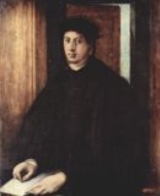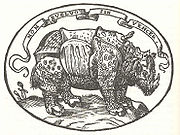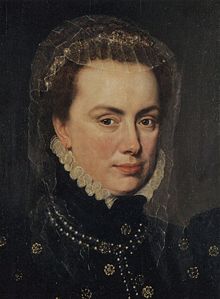
Alessandro de' Medici, Duke of Florence
Encyclopedia
Alessandro de' Medici called "il Moro" ("the Moor
"), Duke
of Penne and also Duke of Florence
(from 1532), ruler of Florence
from 1530 until 1537. Though illegitimate, he was the last member of the "senior" branch of the Medici
to rule Florence and the first to be a hereditary duke.
, the Magnificent), but many scholars today believe him to be in fact the illegitimate son of Giulio de' Medici (later Pope Clement VII
), nephew of Lorenzo de' Medici
, the Magnificent. Historians (such as Christopher Hibbert) believe he had been born to a mulatto servant who was working in the Medici household, identified in documents as Simonetta da Collevechio. The nickname is said to derive from his features (Hibbert 1999: 236).

 When Emperor Charles V sacked Rome in 1527, the Florentines took advantage of the turmoil in Italy to reinstall the Republic; both Alessandro and Ippolito
When Emperor Charles V sacked Rome in 1527, the Florentines took advantage of the turmoil in Italy to reinstall the Republic; both Alessandro and Ippolito
fled, along with the rest of the Medici and their main supporters, including the Pope's regent, Cardinal Silvio Passerini
, with the exception of the eight-year-old Caterina de' Medici
, who was left behind. Michelangelo
, then occupied in creating a funerary chapel for the Medici
, initially took charge of building fortifications around Florence in support of the Republic; he later temporarily fled the city. Clement eventually made his peace with the Emperor, and with the support of Imperial troops, the Republic was overwhelmed after a lengthy siege, and the Medici were restored to power in the summer of 1530. Clement assigned Florence to nineteen-year-old Alessandro, who had been made a duke, an appointment that was purchased from Charles. He arrived in Florence to take up his rule on July 5, 1531, and was made hereditary Duke of Florence 9 months later by the Emperor (for Tuscany lay outside the Papal States), thereby signalling the end of the Republic (Hibbert 1999: 250–252; and Schevill 1936: 482, 513–514).
His many enemies among the exiles declared that his rule was harsh, depraved and incompetent, an assessment debated by later historians. One relic of his rule sometimes pointed out as a symbol of Medici
oppression is the massive Fortezza da Basso, today the largest historical monument of Florence
. In 1535 the Florentine opposition sent his cousin Ippolito to appeal to Charles V against some actions of the Duke, but Ippolito died en route; rumors were spread that he had been poisoned at Alessandro's orders (Hibbert 1999: 254).
In a late replay of the kind of medieval civil politics that had long revolved around pope and emperor, commune and lord, the Emperor supported Alessandro against the republicans. In 1536, he married his natural daughter Margaret of Austria to Alessandro. For his own inclinations, Alessandro seems to have remained faithful to one mistress, Taddea Malaspina
, who bore his only children Giulio de' Medici
(c. 1540-1600), who also had illegitimate issue, and Giulia de' Medici
, who married her cousin Bernardetto de' Medici, Signore di Ottaiano, and had issue.
 Four years later his distant cousin Lorenzino de' Medici
Four years later his distant cousin Lorenzino de' Medici
, nicknamed "Lorenzaccio" ("bad Lorenzo"), assassinated him. (This event is the subject of Alfred de Musset's play "Lorenzaccio.") Lorenzino entrapped Alessandro through the ruse of a promised arranged sexual encounter with Lorenzino's sister Laudomia, a beautiful widow. For fear of starting an uprising if news of his death got out, Medici officials wrapped Alessandro's corpse in a carpet and secretly carried it to the cemetery of San Lorenzo, where it was hurriedly buried.
Lorenzino, in a declaration published later, said that he had killed Alessandro for the sake of the republic. When the anti-Medici faction failed to rise, Lorenzino fled to Venice
, where he was killed in 1548. The Medici
supporters (called "Palleschi
" from the balls on the Medici
arms) ensured that power then passed to Cosimo I de' Medici, the first of the "junior" branch of the Medici
to rule Florence
.
Alessandro was survived by two natural children of Taddea's: a son, Giulio
(aged four at the time of his father's death) married to Lucrezia Gaetani, and a daughter, Giulia married firstly to Francesco Cantelmo, the Count of Alvito and the Duke of Popoli and then Bernadetto de' Medici
, prince of Ottaiano.
Moors
The description Moors has referred to several historic and modern populations of the Maghreb region who are predominately of Berber and Arab descent. They came to conquer and rule the Iberian Peninsula for nearly 800 years. At that time they were Muslim, although earlier the people had followed...
"), Duke
Duke
A duke or duchess is a member of the nobility, historically of highest rank below the monarch, and historically controlling a duchy...
of Penne and also Duke of Florence
Duke of Florence
Il Duca di Firenze, rendered in English as The Duke of Florence, was a title created in 1532 by Pope Clement VII. There were effectively only two dukes, Alessandro de' Medici and Cosimo de' Medici, the second duke being elevated to The Grand Duke of Tuscany, causing the Florentine title...
(from 1532), ruler of Florence
Florence
Florence is the capital city of the Italian region of Tuscany and of the province of Florence. It is the most populous city in Tuscany, with approximately 370,000 inhabitants, expanding to over 1.5 million in the metropolitan area....
from 1530 until 1537. Though illegitimate, he was the last member of the "senior" branch of the Medici
Medici
The House of Medici or Famiglia de' Medici was a political dynasty, banking family and later royal house that first began to gather prominence under Cosimo de' Medici in the Republic of Florence during the late 14th century. The family originated in the Mugello region of the Tuscan countryside,...
to rule Florence and the first to be a hereditary duke.
Life
Born in Florence, he was recognized as the only son of Lorenzo II de' Medici (grandson of Lorenzo de' MediciLorenzo de' Medici
Lorenzo de' Medici was an Italian statesman and de facto ruler of the Florentine Republic during the Italian Renaissance. Known as Lorenzo the Magnificent by contemporary Florentines, he was a diplomat, politician and patron of scholars, artists and poets...
, the Magnificent), but many scholars today believe him to be in fact the illegitimate son of Giulio de' Medici (later Pope Clement VII
Pope Clement VII
Clement VII , born Giulio di Giuliano de' Medici, was a cardinal from 1513 to 1523 and was Pope from 1523 to 1534.-Early life:...
), nephew of Lorenzo de' Medici
Lorenzo de' Medici
Lorenzo de' Medici was an Italian statesman and de facto ruler of the Florentine Republic during the Italian Renaissance. Known as Lorenzo the Magnificent by contemporary Florentines, he was a diplomat, politician and patron of scholars, artists and poets...
, the Magnificent. Historians (such as Christopher Hibbert) believe he had been born to a mulatto servant who was working in the Medici household, identified in documents as Simonetta da Collevechio. The nickname is said to derive from his features (Hibbert 1999: 236).


Ippolito de' Medici
Ippolito de' Medici was the illegitimate only son of Giuliano di Lorenzo de' Medici.Ippolito was born in Urbino. His father died when he was only five , and he was subsequently raised by his uncle Pope Leo X and his cousin Giulio.When Giulio de' Medici was elected pope as Clement VII, Ippolito...
fled, along with the rest of the Medici and their main supporters, including the Pope's regent, Cardinal Silvio Passerini
Silvio Passerini
Silvio Passerini was an Italian cardinal.-Biography:Born in Cortona, Passerini was taken under the wing of the powerful Florentine Medici family, after his father, Rosado, was imprisoned for too openly supporting the Medici cause during one of the reversals of power in 15th‑century Florence...
, with the exception of the eight-year-old Caterina de' Medici
Catherine de' Medici
Catherine de' Medici was an Italian noblewoman who was Queen consort of France from 1547 until 1559, as the wife of King Henry II of France....
, who was left behind. Michelangelo
Michelangelo
Michelangelo di Lodovico Buonarroti Simoni , commonly known as Michelangelo, was an Italian Renaissance painter, sculptor, architect, poet, and engineer who exerted an unparalleled influence on the development of Western art...
, then occupied in creating a funerary chapel for the Medici
Medici
The House of Medici or Famiglia de' Medici was a political dynasty, banking family and later royal house that first began to gather prominence under Cosimo de' Medici in the Republic of Florence during the late 14th century. The family originated in the Mugello region of the Tuscan countryside,...
, initially took charge of building fortifications around Florence in support of the Republic; he later temporarily fled the city. Clement eventually made his peace with the Emperor, and with the support of Imperial troops, the Republic was overwhelmed after a lengthy siege, and the Medici were restored to power in the summer of 1530. Clement assigned Florence to nineteen-year-old Alessandro, who had been made a duke, an appointment that was purchased from Charles. He arrived in Florence to take up his rule on July 5, 1531, and was made hereditary Duke of Florence 9 months later by the Emperor (for Tuscany lay outside the Papal States), thereby signalling the end of the Republic (Hibbert 1999: 250–252; and Schevill 1936: 482, 513–514).
His many enemies among the exiles declared that his rule was harsh, depraved and incompetent, an assessment debated by later historians. One relic of his rule sometimes pointed out as a symbol of Medici
Medici
The House of Medici or Famiglia de' Medici was a political dynasty, banking family and later royal house that first began to gather prominence under Cosimo de' Medici in the Republic of Florence during the late 14th century. The family originated in the Mugello region of the Tuscan countryside,...
oppression is the massive Fortezza da Basso, today the largest historical monument of Florence
Florence
Florence is the capital city of the Italian region of Tuscany and of the province of Florence. It is the most populous city in Tuscany, with approximately 370,000 inhabitants, expanding to over 1.5 million in the metropolitan area....
. In 1535 the Florentine opposition sent his cousin Ippolito to appeal to Charles V against some actions of the Duke, but Ippolito died en route; rumors were spread that he had been poisoned at Alessandro's orders (Hibbert 1999: 254).
In a late replay of the kind of medieval civil politics that had long revolved around pope and emperor, commune and lord, the Emperor supported Alessandro against the republicans. In 1536, he married his natural daughter Margaret of Austria to Alessandro. For his own inclinations, Alessandro seems to have remained faithful to one mistress, Taddea Malaspina
Taddea Malaspina
Taddea Malaspina was an Italian marchesa. She was the mistress of Alessandro de' Medici, Duke of Florence from the early 1530s to about 1537 and was likely the mother of at least two of his children, Giulio di Alessandro de' Medici and Giulia de' Medici. Giulio de' Medici was associated with the...
, who bore his only children Giulio de' Medici
Giulio de' Medici
Giulio de' Medici may refer to:*Pope Clement VII, Giulio di Giuliano de' Medici, *Giulio di Alessandro de' Medici , illegitimate son of the last ruler of Florence from the "senior" branch of the Medici, Alessandro de' Medici...
(c. 1540-1600), who also had illegitimate issue, and Giulia de' Medici
Giulia de' Medici
Giulia Romola di Alessandro de' Medici was the illegitimate, possibly biracial, daughter of Alessandro de' Medici, Duke of Florence and his mistress Taddea Malaspina....
, who married her cousin Bernardetto de' Medici, Signore di Ottaiano, and had issue.
Death

Lorenzino de' Medici
Lorenzino de' Medici , sometimes called Lorenzaccio de' Medici, was an Italian writer remembered primarily as the assassin of Alessandro de' Medici, duke and ruler of Florence.-Biography:...
, nicknamed "Lorenzaccio" ("bad Lorenzo"), assassinated him. (This event is the subject of Alfred de Musset's play "Lorenzaccio.") Lorenzino entrapped Alessandro through the ruse of a promised arranged sexual encounter with Lorenzino's sister Laudomia, a beautiful widow. For fear of starting an uprising if news of his death got out, Medici officials wrapped Alessandro's corpse in a carpet and secretly carried it to the cemetery of San Lorenzo, where it was hurriedly buried.
Lorenzino, in a declaration published later, said that he had killed Alessandro for the sake of the republic. When the anti-Medici faction failed to rise, Lorenzino fled to Venice
Venice
Venice is a city in northern Italy which is renowned for the beauty of its setting, its architecture and its artworks. It is the capital of the Veneto region...
, where he was killed in 1548. The Medici
Medici
The House of Medici or Famiglia de' Medici was a political dynasty, banking family and later royal house that first began to gather prominence under Cosimo de' Medici in the Republic of Florence during the late 14th century. The family originated in the Mugello region of the Tuscan countryside,...
supporters (called "Palleschi
Palleschi
The palleschi, also known as bigi, were partisans of the Medici family in Florence. The name derived by the Medici Coat of Arm, containing six 'balls' ....
" from the balls on the Medici
Medici
The House of Medici or Famiglia de' Medici was a political dynasty, banking family and later royal house that first began to gather prominence under Cosimo de' Medici in the Republic of Florence during the late 14th century. The family originated in the Mugello region of the Tuscan countryside,...
arms) ensured that power then passed to Cosimo I de' Medici, the first of the "junior" branch of the Medici
Medici
The House of Medici or Famiglia de' Medici was a political dynasty, banking family and later royal house that first began to gather prominence under Cosimo de' Medici in the Republic of Florence during the late 14th century. The family originated in the Mugello region of the Tuscan countryside,...
to rule Florence
Florence
Florence is the capital city of the Italian region of Tuscany and of the province of Florence. It is the most populous city in Tuscany, with approximately 370,000 inhabitants, expanding to over 1.5 million in the metropolitan area....
.
Alessandro was survived by two natural children of Taddea's: a son, Giulio
Giulio di Alessandro de' Medici
Giulio de' Medici was the illegitimate son of Alessandro de' Medici, the Duke of Florence, and probably of Taddea Malaspina....
(aged four at the time of his father's death) married to Lucrezia Gaetani, and a daughter, Giulia married firstly to Francesco Cantelmo, the Count of Alvito and the Duke of Popoli and then Bernadetto de' Medici
Bernadetto de' Medici
Bernadetto de' Medici was an Italian patrician who moved from Florence to Naples.A member to a secondary branch of the Medici Family , he was the son of Ottaviano de' Medici and Bartolomeo Giugni...
, prince of Ottaiano.
External links
- Alessandro de Medici PBSPublic Broadcasting ServiceThe Public Broadcasting Service is an American non-profit public broadcasting television network with 354 member TV stations in the United States which hold collective ownership. Its headquarters is in Arlington, Virginia....
online page discussing his ancestry, and his heirs (Note: this article is known to contain at least one elementary error, involving the well-known Medici tombs.). Updated in A View on Race and the Art World. - http://www.vam.ac.uk/content/articles/a/africans-in-medieval-and-renaissance-art-duke-alessandro-de-medici/Victoria & Albert Museum website article discussing Alessandro de' Medici in the context of the depiction of Africans in medieval and Renaissance art.

